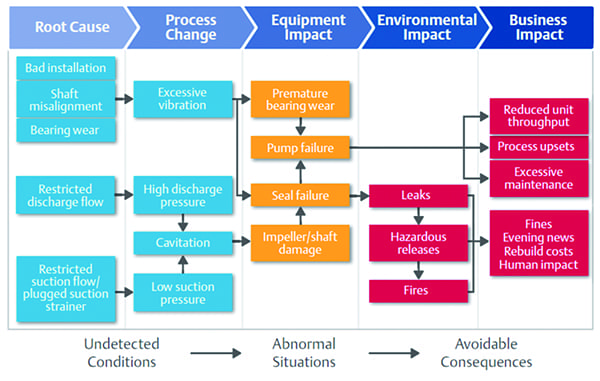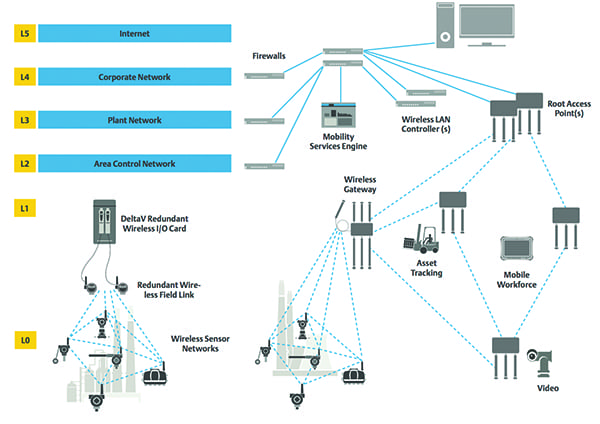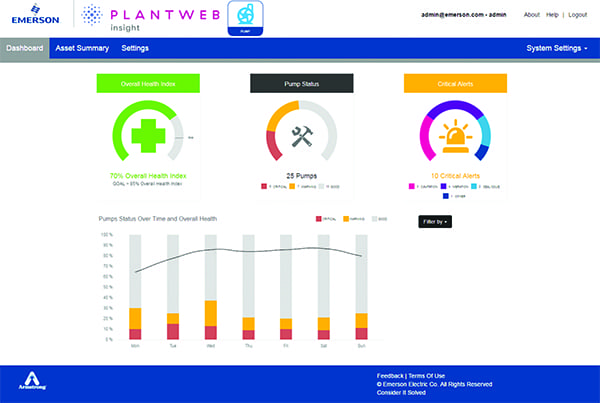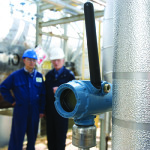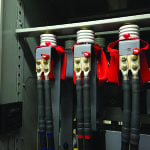All the elements necessary to implement a complete and economical pump monitoring system are now available. It’s simply a matter of assembling the pieces.
Within the walls of a thermal generating plant using any fuel or technology, there is a large population of pumps performing a variety of important services. Whether nuclear, combined cycle gas turbine, or coal, liquids must keep moving. If a critical pumping function is lost, a unit will often have to shut down.
Studies show pumps tend to be some of the more maintenance-intensive equipment in a plant, suffering a failure or some level of degraded operation on average every 12 months. Pumps in especially critical situations often have duplex and even triplex installations as backups, ready to switch over at a moment’s notice, such is their importance.
Reactive maintenance, where it is necessary to fix something that has failed, costs 50% more than practicing predictive maintenance where problems can be detected and resolved before a failure. Pumps can be equipped with sensors to monitor condition and performance to ensure problems are detected as soon as possible so appropriate action can be taken. Pumps are commonly equipped with sensors to monitor specific variables, such as:
- ■ Vibration
- ■ Bearing temperature
- ■ Inlet/outlet pressure
- ■ Strainer clogging
- ■ Seal fluid pressure/level
In most power plants, the list of pump installations equipped with a full monitoring sensor array is short. Those lower on the criticality scale depend on operators on routine rounds using their eyes, ears, and even noses to identify developing problems. Given the reduced number of human operators in plants these days, this means the checks are probably not as regular or as frequent as they should be.
Moreover, checking something like vibration with a hand-held device requires the operator to get right next to the installation, regardless of where it is located. This involves obvious safety concerns, along with the likelihood that a difficult to access installation might not receive the attention it should. All these factors taken together explain the dependence on expensive redundant installations to ensure continuous service.
Insufficient monitoring causes negative business impacts in a variety of ways as undetected conditions result in abnormal situations (Figure 1). In addition to outright unit outages, poor pump performance can contribute to reduced capacity and lower heat rate, sapping profitability.
Automating Monitoring
Existing critical installations with monitoring sensors prove that performance and condition monitoring can be automated. Sensors are accurate and reliable, and capable of detecting many problems early enough to prevent forced outages. The problem is the cost of installing such systems. Why are they so expensive? Let’s look at the breakdown one part at a time:
- ■ A full complement of monitoring devices can require monitoring 10 or more variables for a single multi-pump installation, all reporting back to the automation system via cables.
- ■ The cost of adding devices must include cabling, which can be very expensive and disruptive to ongoing operations.
- ■ The unit’s automation system needs to have sufficient capacity (such as inputs and processing bandwidth) to handle the additional information.
- ■ Appropriate operator interface screens must be created with alarms to help operators see what’s happening and to call attention to critical events as they develop.
- ■ For best performance, specialized software needs to be purchased and configured to give early warning of developing pump problems.
Adding up all these elements can result in a hefty price tag and long implementation times, which is why so few pumps are equipped with a full monitoring system. This creates a dilemma since asset health cannot be determined without monitoring data. No data means no visibility, with pumps simply running to failure.
Fortunately, in the last few years, the situation has been changing for the better. The pieces to assemble a full pump monitoring system at a much lower cost are all available, built on pervasive sensing concepts.
Solution Part 1: Wireless Sensors
Over the last few years, the number of devices designed for equipment monitoring capable of operating on wireless networks has grown substantially. Some communicate using a plant’s Wi-Fi network, but a larger group has been designed to communicate via WirelessHART, the same network used by many types of wireless field instruments (Figure 2). The variety of low-power and low-bandwidth devices designed for these networks has grown enormously, and for all practical purposes, every type of monitoring device necessary for a full pump monitoring setup is available for use with WirelessHART networks (See sidebar).
For plants where a WirelessHART network is already established, adding more sensors is a very simple process. Depending on the numbers of new sensors, an additional gateway may be required, but this is usually an easy step. New sensors can be added quickly and require no wiring whatsoever, as most are powered by internal power modules able to support the transmitters for years at a time. One or more sensors can therefore be installed and added to the network in a matter of hours.
Sensors for Pump Installation MonitoringThe approach to monitoring a given pump will depend on its size and configuration, but the range of sensors listed below is typical. It is important to use a multi-measurement approach because a single sensing technology cannot find every type of developing problem. Bearing Temperature Sensor. A change in the bearing temperature in the pump and/or motor can indicate a developing failure or a change in loading. Vibration Transmitter. Increased vibration can result from a number of causes, and none are good. They can include shaft misalignment, bearing wear, seal wear, shaft bending, and so forth. Cavitation also produces recognizable vibration patterns. Level Switch. Seal flushing systems require verification of sufficient liquid in the external storage tank, and a vibrating-fork level switch is a typical sensor used in these applications. Differential-Pressure Transmitter. The pressure drop across a strainer can indicate debris accumulation. Monitoring the pressure differential between the inlet and outlet of a pump can indicate overall efficiency and help identify conditions where cavitation is likely to occur. As can be seen from the list, some problems, such as bearing deterioration, can be detected by multiple means. The various sensor technologies tend to overlap, complimenting each other by working together to help diagnose problems. For example, increased vibration might be caused by shaft misalignment or by bearing deterioration. If the bearing temperature and noise have not increased, the technician doing the troubleshooting can verify alignment first since it is consistent with the symptoms. |
Solution Part 2: Effective Dashboards
Some users may reach this point and say, “Wireless sensors are all well and good. Yes, they reduce wiring costs, but sensors alone do not make a system. There still needs to be a means to convert all the data into useful information, which is a major cost in itself, requiring substantial time and expertise.”
Under normal circumstances, this is absolutely true. If a system integrator has to be brought in to create new operator interface screens and write new code to bring all these new tags into the plant’s automation system, this could be a huge expense. Fortunately, it’s now an unnecessary expense because new apps are available for health monitoring in conjunction with the wireless instrumentation, independent of the plant’s real-time automation system. These apps are easy to configure using pre-designed data gathering functions and models (Figure 3).
These apps make it simple to perform real-time asset monitoring of a pump installation by identifying abnormal situations as they develop. Pre-packaged analytics evaluate health against unit history and industry norms, and the information is displayed via intuitive dashboards. All of this is possible with minimal configuration effort and no additional loading on the existing automation system. If desired, reporting and alarming functions can be added to external systems, but this is entirely optional.
These apps are easy to use because each is configured for a specific type of asset. Just as there are apps for pump monitoring, there are corresponding apps for other types of assets such as steam traps, heat exchangers, cooling towers, pressure relief devices, and more. This specialization helps deliver sophisticated analytics without having to create customized programming. The customization is already built into the platform, supporting fast implementation.
The Case for Pervasive Sensing Systems
The electric utility industry has benefited enormously from the growth of sophisticated monitoring and communication technologies over the last 10-plus years. Many of these technologies center on distribution with smart meters, smart grids, and other elements of improved power delivery. Some of the same capabilities have made it into generating facilities, but this has often lagged what has happened outside the fence line.
The generation side is evolving rapidly, driven by changes from many directions. Utilities need to look for the same kinds of gains made in distribution efficiency within their generating units. New technologies under the umbrella of pervasive sensing systems have brought important tools necessary to improve generating efficiencies, while reducing carbon footprint. Pump monitoring is just one example of the ways utilities can use pervasive sensing concepts to improve the profitability of their generating fleets quickly, easily, and economically. ■
—Brian Joe is a wireless manager for Emerson Automation Solutions in Minneapolis, Minnesota,responsible for analyticapps and solutions.


